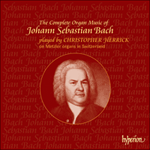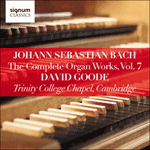The Toccata in E major, BWV566, also exists in a version in C major but again the lack of an autograph makes it impossible to say which is the earlier form of the work. It follows closest the form of the
praeludium as found in Buxtehude, Bruhns and Lübeck in which two fugues, with thematically linked subjects, are enclosed by toccata-like passages (hence the four tracks in which this performance is presented). However, the grandness of Bach’s design and the thoroughness of the motivic working far surpass anything to be found in the models. The two fugue subjects both describe a falling arpeggio; the first has the repeated notes with which he maintains the independence of the part-writing in the first fugue so characteristic of the period, whilst the second is in triple time. The thoroughness is particularly striking as is the use of an idea from the final section of the initial toccata to provide material for the episodes. A brief passage of rhetoric separates the fugues, full of rushing scales and a new dotted figure in the pedals. The final toccata section is more fully integrated into the fabric of the piece than many and achieves a satisfying sense of unity by being closely developed from ideas found in the first.
from notes by Stephen Westrop © 1997
Die Toccata in E-Dur, BWV566, existiert auch in einer C Dur Version, doch auch hier läßt sich mangels eines Originalmanuskripts nicht bestimmen, welche der beiden Versionen zuerst entstand. Dieses Werk lehnt sich eng an die Präludiumsform an, die wir bei Buxtehude, Bruhns oder Lübeck finden, und dergemäß zwei thematisch verbundene Fugen von tokkataähnlichen Passagen gerahmt werden (daher die vierfache Ausführung dieses Vortrags). Bachs Entwurf übertrifft seine Vorlagen jedoch in Bezug auf Vornehmheit und Gründlichkeit der Motivverarbeitung. Beide Fugenthemen beschreiben ein fallendes Arpeggio: Das erste Thema beinhaltet die für diese Epoche so typischen Notenwiederholungen, während das zweite Thema im Dreiertakt steht. Die Sorgfalt, mit der Bach die Unabhängigkeit der Stimmen in der ersten Fuge aufrechterhält, ist besonders beeindruckend, ebenso wie die Verwendung einer Idee aus dem Schlußteil der ursprünglichen Toccata zwecks Materialbeschaffung für die Episoden. Durch eine kurze rhetorische Passage voller eilender Tonleitern und neuer punktierter Figuren in den Pedalstimmen sind die beiden Fugen voneinander getrennt. Der abschließende Toccatateil ist stärker in das Gefüge des Stückes eingebunden als die anderen Abschnitte und erzeugt aufgrund seiner detailgetreuen Entwicklung auf der Grundlage von Ideen der ersten Fuge ein starkes Gefühl der Geschlossenheit.
aus dem Begleittext von Stephen Westrop © 1997
Deutsch: Manuela Hübner


 Bach: The Complete Organ Works
Bach: The Complete Organ Works Bach: The Complete Organ Works, Vol. 7
Bach: The Complete Organ Works, Vol. 7
